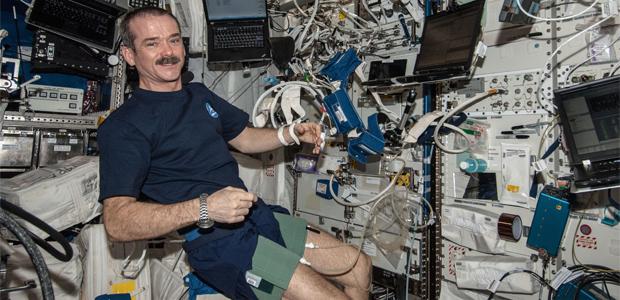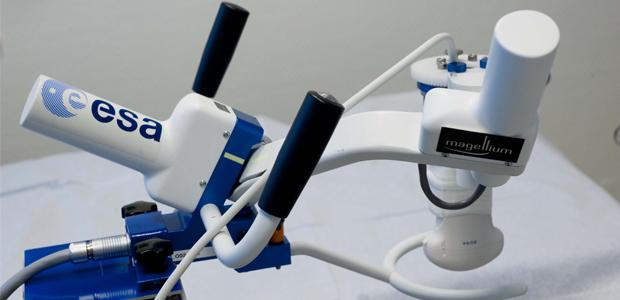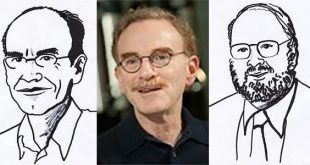While Commander Hadfield’s body readjusts to life on Earth, researchers from Canada and France are studying him so they can better understand the changes that astronauts’ bodies experience while in space.
When Commander Chris Hadfield spoke to the world, he talked about the journey his body’s taking – along with the team of doctors helping him – while it readjusts to life on terra firma.
He also talked about being poked and prodded by an international team of researchers hoping to better understand the changes astronauts undergo while in orbit.
“I’m a full size, human lab rat and there’s no other way to make this transition happen on Earth,” Commander Hadfield said. “It’s just a gift of weightlessness.”
Some of the other gifts of weightlessness are more subtle to the astronauts and the University of Waterloo’s Richard Hughson, is just one of the researchers trying to understand them.
He’s studying Commander Hadfield – along with eight other astronauts, four of each gender – to see how long duration spaceflight might affect the health of their blood vessels.
“Because they’re so physically inactive, it might accelerate the aging-like process of the arteries,” Hughson told SciFare.com.
Other researchers have found that narrowing and hardening of the arteries may be occurring in animal experiments that simulate the long term effects of spaceflight. So, Hughson and his team are using ultrasound technology to monitor how their blood vessels might be changing.
They’re also collecting blood and tracking more than 30 signals to look for potential hints.
“Those blood samples are looking for specific markers that might be related to the arterial stiffness,” Hughson said.
Full results aren’t expected for some time – the last of the astronauts, Karen Nyberg, won’t be back until the end of 2013 and some of Commander Hadfield’s blood samples are still on the ISS too – but Hughson said four of them have blood samples that are already yielding some interesting results.
“We’ve seen that a couple of these markers change very consistently in all four,” Hughson said.
This isn’t the first time Hughson’s team has studied the long term effects of microgravity on astronauts – that’s the technical term for studying the gifts of weightlessness.
In 2012, they published a study looking at how long term spaceflight might affect their innate ability to regulate blood pressure – many astronauts have talked about the dizzy feeling they experience after they return home from space.
“It was a little bit reduced after spaceflight, so they’ve lost a little bit of the ability to respond to a drop in blood pressure,” Hughson said.
We experience a similar feeling if we stand up too quickly and it’s the response our body has to make after standing up that may have temporarily gone awry in the astronauts.
“That drops the pressure down at the heart level and you get reflexes that kick in to try and bring the blood pressure back up,” Hughson said.
The blood pressure at our head drops – it’s about 30 per cent less than when we’re lying down – because gravity starts pushing the blood towards our feet. The amount of blood headed to the brain stays fairly constant.
“That’s because the brain’s blood vessels dilate just enough to bring the blood flow back up to where it should be again,” Hughson said.
After we’ve adjusted to life with our head above our heart, the amount of oxygen and nutrients flowing to the brain needs to be maintained. When the oxygen level decreases, it signals our vessels to dilate – just like it does when we stand up – so the amount of oxygen in our tissues doesn’t drop.
“We think nitric oxide is one of the main contributors to dilation of the brain blood vessels,” Hughson said.
In addition to seeing a temporary drop in the astronauts’ ability to regulate their blood pressure, researchers also found a small decrease in their blood vessels’ ability to dilate in response to an increase in carbon dioxide levels – an increase in carbon dioxide is the same as a decrease in oxygen.
“If you’ve had a reduction in the carbon dioxide response, it might mean that you’ve got a somewhat reduced nitric oxide response,” Hughson said.
How it changes isn’t clear, but the body may be adjusting to another new normal – the oxygen levels onboard the ISS are similar to those on Earth, but the levels of carbon dioxide are about ten times higher, so it may be due to a rebalancing effort too. The answers may be waiting for them in the blood samples they’re collecting now though.
Animal models of space-like conditions hint at other changes the astronauts may be experiencing while they’re in orbit. In fact, Hughson said his team’s about to submit some research that shows the shape of the astronauts’ blood vessels may be changing in space just like the animal models did.
“Because of that sustained, elevated pressure, the blood vessel walls might get thicker,” Hughson said.
Tracking the subtle changes in their shape is easy when you’re an ultrasound expert like Dr. Philippe Arbeille – the physicist and physician is also part of the team studying the astronauts.
He’s also developing a robot that would allow him to control an onboard ultrasound probe from his office in Tours, France – it’s not as easy for astronauts who only have a basic level of training.
“The major challenge is to collect a good view of the organ,” Dr. Arbeille told SciFare.com.
His team’s off to a good start. They’ve already developed a version of the robot that allows him to remotely control ultrasound probes that have been set up in rural French communities.
Working with the local physician, the probe is set on the region of interest and from his office at the Université de Tours, Dr. Arbeille makes the fine adjustments via an internet and video connection.
“As soon as he puts the robot on the body, we take control of the robot and take the image,” Dr. Arbeille said.
He said longer range tests in Spain and Romania have also yielded similar, high quality images.
“The objective was to use satellite communication to see if the image, as it travels through the satellite network, is destroyed,” Dr. Arbeille said.
His next goal is to reduce its size and weight – dramatically. It’s currently about the size of a robot vacuum cleaner and in order for it to fly on the ISS, it needs to shrink to about the size of a tennis ball.
This sort of collateral benefit isn’t unique. A lot of the changes that an astronaut experiences in space, are similar to challenges faced by people as they age. Understanding where they converge may help researchers develop better interventions for everyone.
“If we can identify things that are changing in the astronauts, maybe we can come back and focus on those markers in the aging population,” Hughson said.
Hughson said that astronauts are minimizing the bone-density loss they experience in space by taking osteoporosis medication and his team’s just finished using a lot of the same techniques to look at how the aging process changes the shape and function of blood vessels.
“We showed that as the arteries got stiffer, brain blood flow decreased,” Hughson said.
How it all relates isn’t clear, but Hughson said that looking for connections is something that’s always on his mind.
“We’re all interested in keeping everyone as healthy as possible, for as long as possible,” He said.
 Science Fare Media Science News – Upgraded
Science Fare Media Science News – Upgraded



